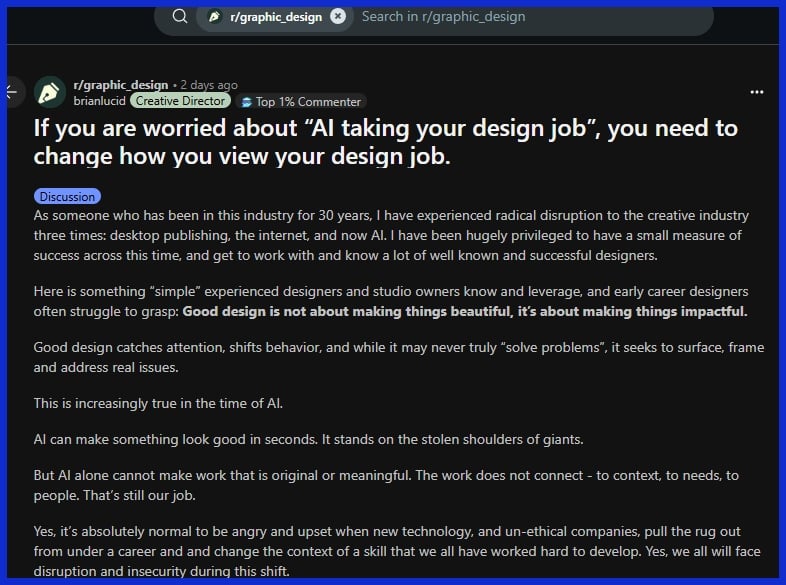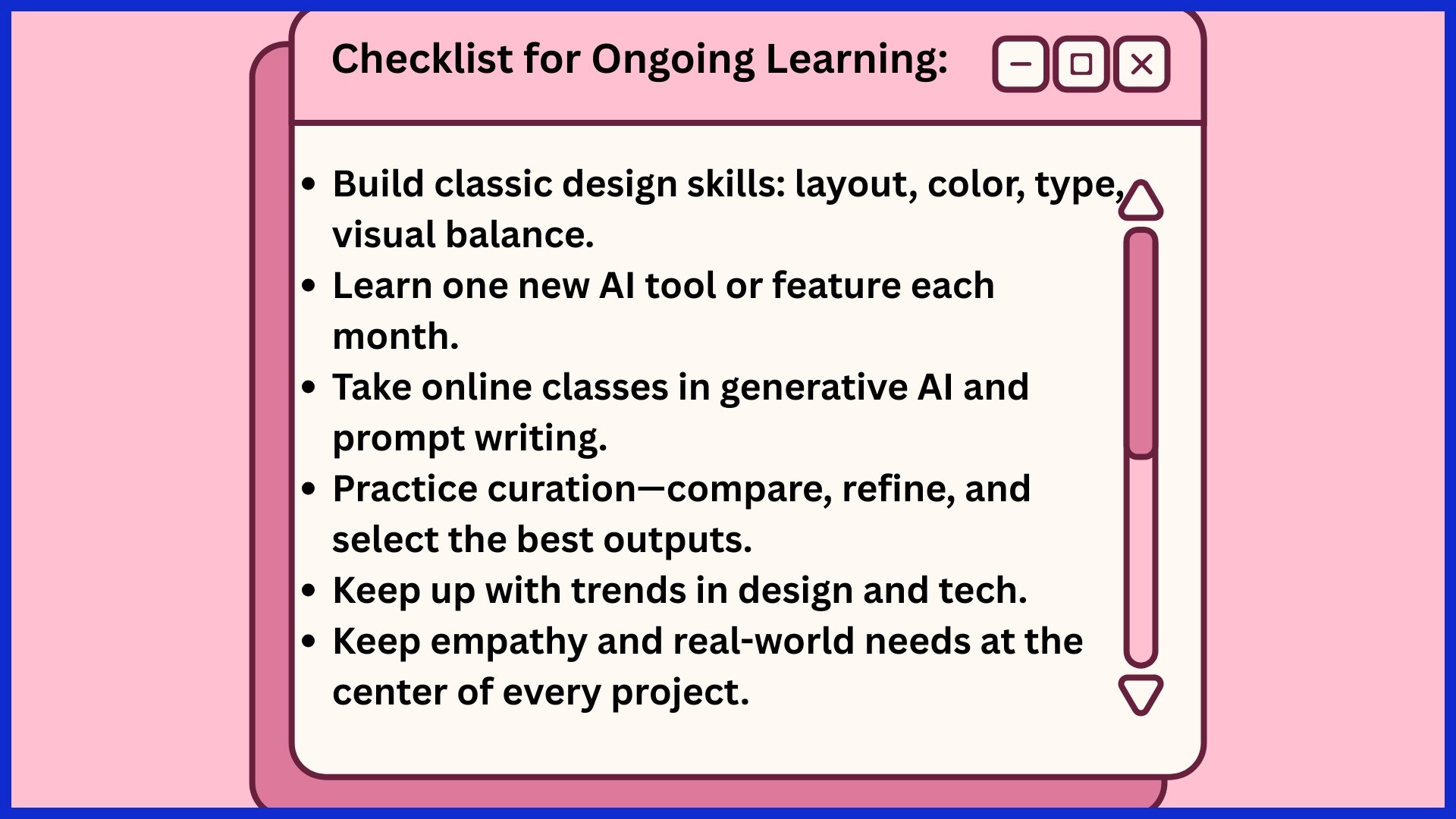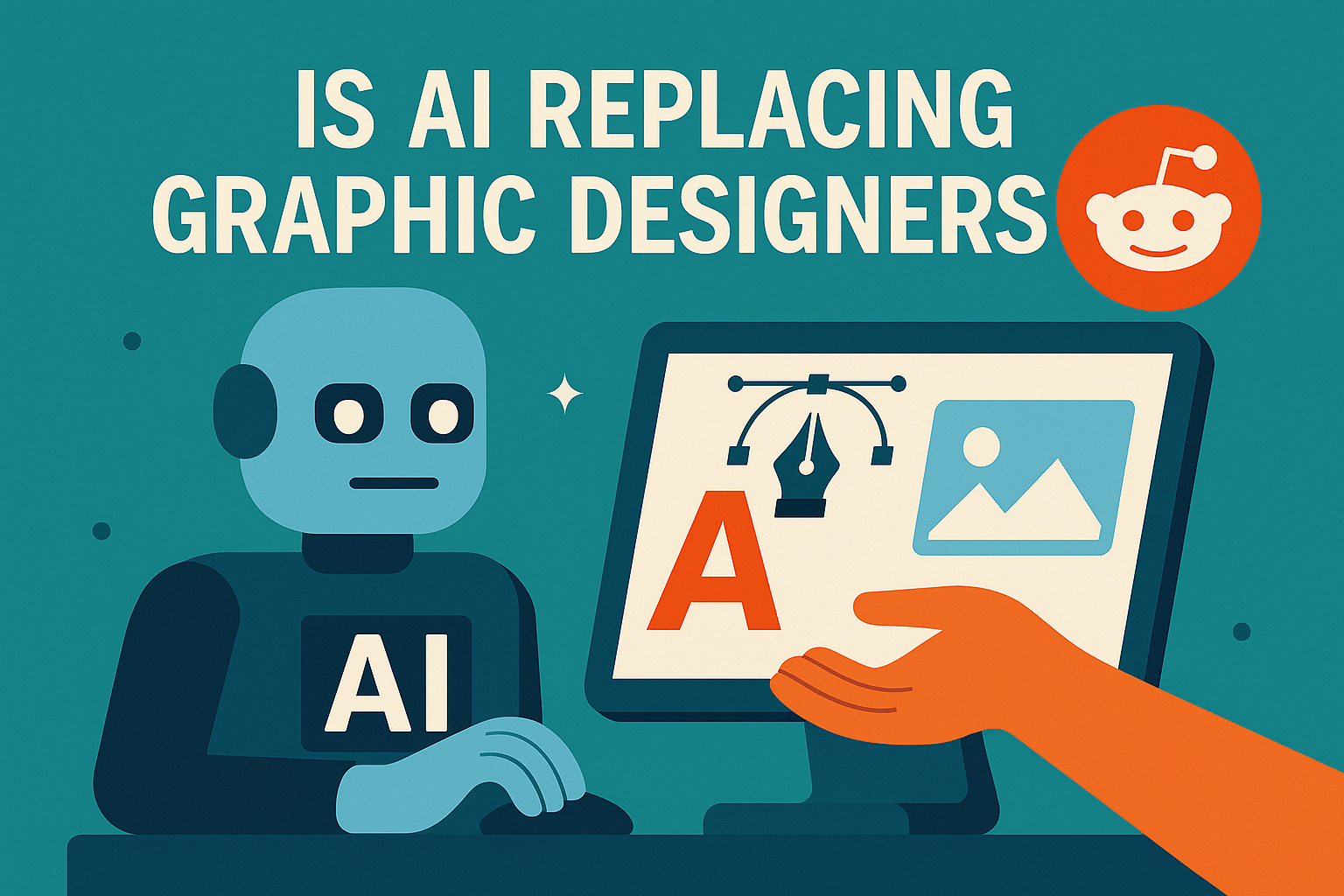Table of Contents
Key Takeaways
-
How ai is transforming graphic design as a graphic designer, I realized ai is automating repetitive aspects of the work, freeing designers to tackle more creative and complex problems.
-
By welcoming AI as a tool and creative partner that helps you generate new ideas and finesse your work, designers can thrive — so learning to code prompts is worthwhile.
-
AI boosts efficiency, but human creativity, intuition, and context remain irreplaceable for impactful and meaningful design.
-
Designers who build niche skills, keep pace with AI, and double down on the human will find new opportunities and thrive.
-
While AI tools democratize design, they demand that designers be original, ethical, and curators.
-
Constant learning, experimentation — that’s what designers need to survive in AI’s new world.
AI is not replacing graphic designers; it’s here to reshape the way design gets done. More and more brands are leaning on AI tools to handle routine tasks like resizing assets, cleaning up visuals, or generating quick color palettes. But when it comes to fresh ideas, emotional nuance, and personalized creativity, designers still hold the upper hand.
What’s emerging is less of a competition and more of a collaboration. With technology advancing at breakneck speed, the most impactful design work now comes from teams that blend AI efficiency with human imagination. In this article, we’ll dive into what Redditors are saying about this shift—and how designers are navigating the balance.

AI’s Real Impact on Designers

AI is not just a graphic design buzzword—it’s transforming the way graphic designers operate and what it means to be a creative professional today. The ascent of AI tools is realigning graphic design roles and workflows, highlighting the skills that count. While some fear AI will miniaturize the industry, others see new career opportunities emerging in model training, creative direction, and human-centered design.
1. Augmentation

AI assists designers by automating boring tasks such as image resizing or file formatting, allowing more hours for courageous thinking and design challenges. With AI taking care of the tedious chunks, designers can immerse themselves in more complex projects, explore new ideas, and really push the boundaries.
Tools such as AI-powered mockup generators and color palette creators ignite new ideas that save time and increase creativity. Designers who acquire AI skills and interweave them with their own style shine in the noise. Fast adapters are ahead, not behind.
Treating AI as a creative ally, not a menace, gives designers the advantage.
2. Automation

Automation is transforming design workflows everywhere. AI does monotonous tasks—like batch-editing, asset generation, or rudimentary layouts—quicker and with fewer errors. This liberates designers from time sinks and enables them to focus on client needs and bespoke visual narratives.
Even a small thing, like using an AI tool to clean up a photo, can save hours. AI can’t see through a client’s eyes or interpret nuance like a human can. Human insight, cultural awareness and empathy are absent from AI’s toolkit.
That’s why savvy teams use AI for grunt work but loop people in on the rest. For agencies or digital marketers, employing AI tools to accelerate work translates into more projects completed on schedule. At Graphically.io, our project quality team ensures that tools and humans work together for maximum impact.
3. Specialization

The rise of AI is dividing the design profession into emerging roles. Some designers now train AI models, or create human–centered design systems — previously uncommon roles a decade ago. There is more space for specialists who know how to get AI tools working for actual-world clients, not tech demos.
If you want to remain in demand, specialize—perhaps it’s UX or branding or AI-powered design systems. The demand for niche designers is rising, particularly in sectors seeking a mix of technology and artistry.
Firms rely on creatives who understand both fundamentals and the newest instruments.
4. Democratization
AI tools are democratizing graphic design skills, allowing non-designers to create logos, banners, or social posts. While this trend opens up new career opportunities, it often leads to generic design outputs. Clients may rely on templates or AI-generated art, but such results can appear stockphoto-ish—lacking depth and emotion.
Graphic designers can leverage the same AI tools to reach larger audiences or offer innovative services. By embracing this evolving landscape, they ensure their relevance in the graphic design industry and can educate clients on the importance of authentic design versus cookie-cutter content.
The Creativity Question

AI can generate visuals faster than any human—but speed isn’t the same as creativity. The real question is: can AI deliver originality, meaning, and emotional depth?
Mimicry vs. Originality

AI is great at mimicking styles, often trained on countless works without credit to the artists. It can produce photorealistic images in seconds, but that raises a problem: if AI keeps recycling patterns, how unique is the result?
Already, research shows that nearly half of people can’t tell AI designs from human ones. That might sound impressive, but it also signals the risk of generic, lookalike work. Designers, by contrast, sketch, refine, and experiment until they uncover that spark of originality—something AI alone can’t provide.
AI is best treated as a starting point, not the final product. It can give you quick drafts, but it takes a human eye to shape those drafts into something meaningful and memorable.
Context
Good design isn’t just decoration—it’s about fit and relevance. A color, symbol, or style that works in one culture may fail in another. AI doesn’t always catch these nuances.
That’s where designers come in. They provide the cultural awareness, audience insight, and contextual understanding that AI lacks. A collaborative workflow—AI for speed, humans for judgment—creates design that’s both efficient and effective.
Intent is Everything

AI doesn’t have intent. It doesn’t know when to bend rules, when to take risks, or when to play it safe. Designers do. They bring vision, purpose, and emotional storytelling—the elements that give design lasting impact.
Think of the Mona Lisa. Its power isn’t just in technique, but in its mystery, emotion, and narrative. That’s the human touch—something AI can’t replicate.
As AI evolves, the designer’s role becomes even more critical—not just using tools, but guiding them. Human creativity, intent, and context are what turn AI output into designs that truly connect.
The New Designer Toolkit
Graphic design is evolving quickly. AI tools are now included in every modern designer’s toolkit, changing the nature of work and possibilities. Designers who stay on top of new tools, from AI image generators to smart editing software, can accomplish more in less time. They can spearhead larger projects and accomplish deadlines that once seemed impossible.
Learning to use these tools is not optional—it’s essential. The finest work emerges from blending the vintage talents—such as drawing, layout, and color—with new technology. When designers combine their creativity with intelligent AI capabilities, the outcome can seem novel.
Idea Generation
AI is a mighty brainstorming partner. Designers employ AI to ignite new ideas or re-energize creative slumps. Rather than facing a blank page, they can run prompts through AI and receive dozens of visual directions in minutes. This, in turn, allows you to more easily find inspiration and push creative boundaries.
It’s crucial not to depend on AI. The optimal outcomes occur when designers combine their personal artistic tone with AI proposals. This keeps work distinctive and helps prevent the ‘cookie-cutter’ appearance that can sometimes afflict AI art. AI is a utility, not a substitute.

Workflow Efficiency
AI reduces grunt work. Tools such as generative fill eliminate unwanted objects or introduce new elements in seconds. Image upscalers and auto-layout features accelerate resizing and formatting. Some designers at Graphically.io utilize these tools to complete projects much more rapidly, providing clients faster turnaround and increased value.
One designer told us they chopped project time in half after switching to AI-powered batch editing. Another team leveraged AI to detect bugs in final files, helping them catch mistakes prior to sending to clients. That demonstrates how AI enhances quality control in addition to velocity.
Asset Creation
AI is convenient for generating personalized graphics, icons, and logos. A few could generate complete illustrations from text prompts—potentially saving hours of manual effort. Designers use AI for first drafts, then customize them by hand to ensure the final asset suits the brand and feels bespoke.
Nevertheless, risks remain. Not all AI graphics will be high quality or fit a client’s aesthetic. Requires human review to maintain brand voice and prevent generic results. Some clients can’t even distinguish what’s human-made and what’s not.
Evolving Your Design Skills
Strong design starts with timeless fundamentals, but staying ahead means pairing that foundation with new tools like AI. While AI speeds up tasks—resizing, layouts, quick fixes—it still needs the human touch to deliver originality and quality. Designers who master both craft and AI stay valuable and relevant.
Strategic Thinking
Design isn’t just about looks—it’s about impact. Clients care about sales, branding, and results. AI can provide data, but it takes a designer’s strategic mind to turn that into outcomes people connect with. The real edge comes from using AI as support, not as the driver.
Prompt Engineering
AI is only as good as the prompts you feed it. Clear, creative prompts unlock better visuals and concepts. Learning how to “speak AI” is now a core design skill—helping you get closer to your vision and opening new career opportunities. Practicing, experimenting, and refining prompts is how designers maximize AI’s potential.
Curation
AI can churn out endless options, but not all will fit the story or brand. The designer’s job is to curate—spotting what works, refining what doesn’t, and blending AI output with personal taste. This judgment is what transforms raw ideas into powerful, human-centered design.
Human-Centricity
Human-centric design, of course, means putting people first. Even with all the AI power, remembering who you’re designing for makes your work special. Empathy, knowing what users feel and need, is an advantage AI can’t simulate.
Instead, emphasize the way your work addresses tangible issues or narrates compellingly. AI assists with data and band-aids, but only humans can hear emotion or feel what makes a design “click.
Learning skills such as interaction design and visual storytelling makes your work pop.

The Unseen Challenges
AI has transformed the graphic design industry in unexpected ways. As clever systems improve at generating art, logos, and layouts, graphic designers everywhere are considering what this implies for their craft and new career opportunities. The transition runs deeper than velocity or price—it strikes at the core of originality, possession, and justice.
|
Challenge |
Details |
|---|---|
|
Job Security |
Many designers fear that AI might take over their roles, especially as some struggle to find work in a tighter market. |
|
Quality Control |
AI can make odd results—six-fingered hands, three-legged people—leaving more work to fix mistakes. |
|
Copyright Issues |
Hard to tell who owns AI-made art; legal rules are still not clear. |
|
Homogenization |
AI often spits out similar looking designs, risking sameness. |
|
Ethics |
Questions rise about using others’ work as AI training data, and the impact on culture. |
Homogenization

When everyone’s running the same AI tools, all the designs begin to merge. AI likes to plagiarize training data, so it plagiarizes training data. Which, in turn, makes it hard for brands to differentiate.
Think about flipping through Facebook and seeing logos or banners that are all the same–no zing, no life. That’s a serious risk.
The fix Designers still have to put their voice and style. It’s the human spin–an interesting font, an unexpected pop of color, a creative new angle for storytelling–that disrupts the carousel of the similar.
Ownership
Who legally owns an AI-generated design? It’s a muddy subject. Laws and liberties are still moving. Some argue the prompt pecking human owns the work, others contend that the company behind the AI tool claims the glory.
It gets even more difficult when AI mashes up pieces from multiple sources.
|
Ownership Issue |
How It’s Changing |
|---|---|
|
Authorship |
Harder to prove who “made” the work |
|
Copyright |
Laws lag behind tech, leaving gray areas |
|
Licensing |
Not always clear if you can use or resell AI-made images |
Ethics
AI can plagiarize styles or even entire works without permission. That threatens uniqueness. Designers should keep it honest, keep it real.
If a design could be confused with someone else’s, or if it borrows too heavily from history, it may wade into plagiarism territory. Designers need to consider how their work forms narratives and culture.
AI is a tool, but it’s on us to use it well. Ethics give us all a sense of what’s right and what isn’t. Keeping these points in mind safeguards not just jobs, but the worth of design itself.
What’s Next for Design?

Design is evolving fast, and AI is now part of the toolkit. Over 65% of businesses already use it—and that number is only growing. But AI isn’t replacing designers; it’s reshaping the role.
AI can draft layouts, generate logos, or speed up edits. Yet it still struggles with nuance—like emotion, culture, or storytelling. That’s where designers shine: blending color, form, and narrative into work that inspires and connects.
The future is co-design—AI handling the grind while humans make the bold moves. This shift frees designers to focus on strategy, innovation, and brand storytelling, not just pixel-pushing.
Of course, copyright and originality are big concerns. If everyone uses the same AI tools, designs risk looking alike. The edge comes from the human touch—the unique style, perspective, and intent only a designer can bring.
In the next few years, AI will be everywhere. Designers who adapt—pairing timeless skills with new tech—will not just survive but thrive.
The takeaway? Stay curious, sharpen your craft, and use AI as an ally. Creativity and bold thinking will always push design forward.
Conclusion
AI is reshaping design, but it will never replace the creativity, intent, and human touch that define great work. Tools evolve, trends shift, but the need for sharp eyes and imaginative minds remains constant.
Yes, AI can churn out polished logos—but only a designer can create one that tells a story, sparks emotion, and truly connects with people. The future of design belongs to those who blend the best of both worlds: the efficiency of AI with the originality of human insight.
Whether you’re a small shop, a growing agency, or a tech-driven team, the magic happens when tools and talent work together. Stay curious, keep experimenting, and focus on what AI can’t replicate—vision, empathy, and storytelling.
Have a project in mind? Partner with Graphically.io and see how real creativity, amplified by smart tools, delivers designs that stand out and stick.
Frequently Asked Questions
Is AI taking over graphic designer jobs?
AI is not completely substituting graphic designers; rather, it automates routine tasks, allowing designers to focus on their creative process and the unique graphic design skills that set them apart.
How can graphic designers use AI in their work?
Designers turn to AI tools to accelerate graphic design tasks such as resizing, background removal, and mockup generation, allowing for more time for creative thinking and complex graphic design projects.
Will AI make graphic design less creative?
AI can handle the mundane tasks, but true creativity is a human endeavor. It enables graphic designers to focus on the creative process, freeing up time to innovate.
Should designers learn AI tools?
Sure, learning AI tools matters for graphic designers. It guides them to remain relevant, optimize efficiency, and diversify their skillsets for today’s graphic design jobs.
What are the main challenges of using AI in design?
Designers in the graphic design industry must ensure quality and ethical outcomes through creative processes and human guidance.
Can AI replace human creativity in design?
No, AI can’t entirely replace human creativity in graphic design careers. While it can assist, only human designers bring emotion, context, and unique perspectives to their creative work.
What skills will future designers need?
Creativity, adaptability, and fluency with graphic design tools will serve future graphic designers well, while powerful communication and problem-solving skills will remain key in the job market.












